2017 Suzuki GSX-R1000 and GSX-R1000R Previews
The battle of the superbikes keeps getting hotter
Well, we knew a new Suzuki GSX-R1000 was on the way, but I don’t know if we were expecting two of them? The one with one “R” is for riding, the one with two – GSX-R1000R – is for racing and packed with lots of things Suzuki says make it ready for Superstock competition right out of the box, oh drool… Both bikes of course are lighter, more powerful and meaner than any GSX-R heretofore. And it’s about time, because it’s been since 2009.
It starts with a new, higher-compression (13.2:1) more-oversquare (76.0 x 55.1mm) inline-Four that’s also, of course, claimed to be lighter and more compact (no more balancer shaft, for one thing). The claim is 202 crankshaft PS at 13,200 rpm, which my Google says equals 199.237 horsepower. If all goes as planned (it seldom does), that might translate to 180 rear-wheel Dynojet horsepower. The torque claim is virtually unchanged, at about 86 lb-ft, but shifts from 10,000 to 10,800 rpm.
In the pounds department, Suzuki claims a curb weight of 441 pounds for the standard non-ABS bike, 445 for the ABS standard, and 448 for the GSX-R1000R (which comes with ABS).
“To defeat the competition,” says Suzuki, “increasing top-end power was an essential target. However, the GSX-R line has always been known for making broad power across the rev range, combining low-end and mid-range torque with an exciting top-end rush. The new GSX-R1000 engine is designed to produce the most top-end power without sacrificing low-end and mid-range power and torque. To achieve this target, technology developed in MotoGP racing has been used in the engine design.”
Suzuki Racing VVT (variable valve timing) is going to help get us there. Way simpler than most systems, what happens is that 12 steel balls running in slanted grooves are spun outward by centrifugal force at high rpm. Their carrier mechanism attaches to the intake cam sprocket, and retards intake cam timing at a pre-set rpm, “adding significantly to high-rpm power.”
“The new GSX-R1000 uses a valvetrain developed in MotoGP competition, using thinner-wall, hollow camshafts operating lighter, F1-style pivoting finger followers. Each finger follower is 6 grams lighter than a conventional bucket tappet (10 grams vs. 16 grams), and because each follower pivots on a fixed shaft, its moving mass is just 3 grams. The lighter moving mass allows maximum engine rpm and valve lift to be increased while improving valve response and maintaining accurate valve control. Each finger follower in the GSX-R1000 is designed based on the actual followers used in the GSX-RR MotoGP racebike, including a DLC coating to increase durability.”
Inside that new airbox, a new Suzuki Dual-Stage Intake (S-DSI) system claims to deliver the advantages of variable-length intake funnels without the extra weight, complexity and cost. Two of the four intake funnels use a new stacked, dual-stage design, with a longer funnel positioned above a short funnel, and a gap between the two parts.
“At low and mid rpm, most of the air flows through the longer, upper funnel into the short funnel, increasing low-end and mid-range power and torque,” says Suzuki. “At higher rpm, more air flows around the base of the longer upper funnel and directly into the short lower funnel, increasing top-end power and torque. The combination of two S-DSI funnels and two conventional funnels helps produce a broader, smoother powerband and a seamless transition from low and mid-range into the higher rpm range.”
Meanwhile, final-drive gearing was shortened a bit to compensate for the taller 190/55-17 Bridgestone the bike comes with, and the drive chain shrinks from a 530 to a 525. Your new SCAS (Suzuki Clutch Assist System) works as a slipper clutch during downshifts, reducing mechanical pressure on the plates, inducing slip and limiting back-torque. Under acceleration, it increases mechanical pressure on the plates, allowing the use of lighter clutch springs and a lighter easier lever.
Control
You can’t hold your head up in modern society without traction control, and the new Suzuki gets a 10-level TCS system it’s calling Motion Track TCS. It’s adjustable on the fly (close the throttle). Working with a new IMU which monitors pitch, roll and yaw – and all those other sensors every 0.004 second – the TC system reduces engine power output when a loss of traction is detected or predicted by managing ignition timing and throttle valve position.
The three ride modes tailor power delivery to suit ambient conditions as well as the rider’s preference, such as riding on a racetrack, on tight and twisty roads, or in urban settings, via a switch on the left handlebar.
Roller
The new GSX-R1000’s main frame has optimized rigidity and was designed using the latest FEM analysis technology and is 10% lighter than the frame of the current GSX-R1000. The steering head and the front engine hanger on each side are now included as part of a single, one-piece cast structure. The swingarm is new and with “optimized rigidity.” A new, simpler subframe of aluminum tubing replaces the old cast one and shaves 2.2 pounds…
S’pension
Your garden variety GSX-R1000 stands pat with its Showa Big Piston Fork. Your Showa shock absorber out back works through a new progressive linkage that Suzuki claims makes the suspension more responsive and increases traction over uneven pavement ripples as well as over larger bumps. Spring preload, rebound damping, and both high-speed and low-speed compression damping are externally adjustable. The linkage dog-bones are made of extruded aluminum alloy.
Brakes
Brembo 320mm discs replace Sunstar 310s, mounted to their carriers with a new hybrid system using a 50/50 combination of five conventional spring-loaded floating pin mounts and five Brembo T-drive floating mounts. The T-drive floating mounts are lighter yet produce a larger contact area between the disc and the carrier, requiring fewer mounts (10) than conventional mounts alone (12), minimizing the weight gain from the larger discs. Conventional spring-loaded pin mounts are slightly heavier and produce a smaller contact area, but are quieter. Using a combination of T-drive and pin mounts reduces rattle and requires fewer mounting points.
The Brembo radial-mount monoblock front calipers have four 32mm pistons each, and work with a radial-pump, 19mm master cylinder.
The GSX-R1000R model and the ABS version of the standard bike come with the new Motion Track Brake System, which works with the IMU. Suzuki says it reduces rear-wheel lift during very hard braking on the racetrack, and allows the use of more aggressive brake pads, producing more initial bite and more total braking force, and helps keep the rear wheel in line. On the GSX-R1000R only, the system also optimizes the brake pressure when the motorcycle is leaning. Correct, lean-sensitive ABS.
What else ya got?
We got MotoGP-inspired, wind-tunnel tested, more aerodynamic bodywork – 16mm narrower at its widest point – designed to contribute to better overall racetrack performance by reducing lift and increasing handling and top speed on the racetrack, held on by mounting bolts redesigned with a new flat-top shape to reduce air resistance. No, really. We got new SRAD intake ducts positioned closer to the center of the fairing nose, where air pressure is highest, thanks to the new compact LED headlight.
Suzuki GSX-R1000R
Plumping for the full monty machine by adding that last R gets you even more go-fast goodness, the biggest benefits being the latest Showa Balance Free suspension bits. The Balance Free Front fork has trickled down from the track, and is said to provide more consistent damping and enhanced performance by delivering smoother, more controlled travel and better dealing with pavement imperfections.
The BFF system equalizes oil pressure above and below a solid internal piston as it moves up and down, pushing oil out of the fork leg and through external damping circuits that run to the other side of the piston, where it is drawn back into the fork leg. The external compression and rebound damping circuits that the oil runs through are more precise than the valve stacks fitted above and below the piston in other types of forks, a difference that Suzuki’s testers say they can feel in the form of improved comfort on the road and better feel and cornering grip on the racetrack. Rebound damping, compression damping and spring preload can be easily adjusted externally.
Same deal with the Showa Balance Free Rear Cushion lite shock out back, with “riders reporting better feel and drive grip that allowed them to initiate their drive sooner and accelerate out of racetrack corners harder. The improvement in damping control is so significant that it is no longer necessary to provide separate high-speed and low-speed compression damping adjustments, and the rear shock is lighter as a result. On the street, the BFRC lite shock absorber is more responsive and improves traction and rider comfort.”
Another cool feature you get with the RR would be a new bi-directional quick-shift system, working both up and downshifts. Monitoring shift-linkage movement and stroke, along with shift-cam rotation and throttle position, the system cuts ignition between 50 and 75 milliseconds (it’s adjustable) for upshifts. For downshifts, it automatically opens the throttle valves just enough to increase rpm and match engine speed to the next-lower gear ratio, then makes you a sandwich.
Then there’s Launch Control, which lets you hold the throttle WFO so all you have to do is work the clutch: “At the moment of launch, the system is set to hold the engine at ideal rpm for an effective launch. Once the clutch lever is released and the clutch engaged, rpm is no longer limited but throttle opening is controlled to keep the engine at the ideal torque for strong acceleration. The launch-control system not only helps the rider get a good initial launch, but also helps reduce the chance that a wheelie off the starting grid will require the rider to close the throttle twist grip. It does so by working with Motion Track TCS and controlling throttle valve opening and ignition timing while monitoring front and rear wheel speeds.
The launch control system automatically disengages when the rider upshifts into third gear or closes the throttle grip.”
Finally, the R gets a distinctive lightweight top triple clamp to remind the owner he’s arrived. Pricing wise, we should have the goods after things are finalized at the AIMExpo in Florida around October 13. I’m bushed.
More by John Burns




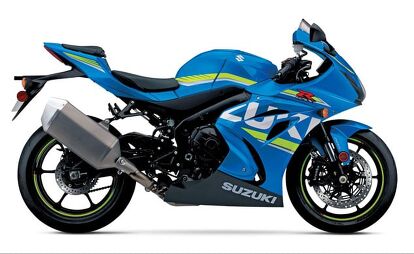
















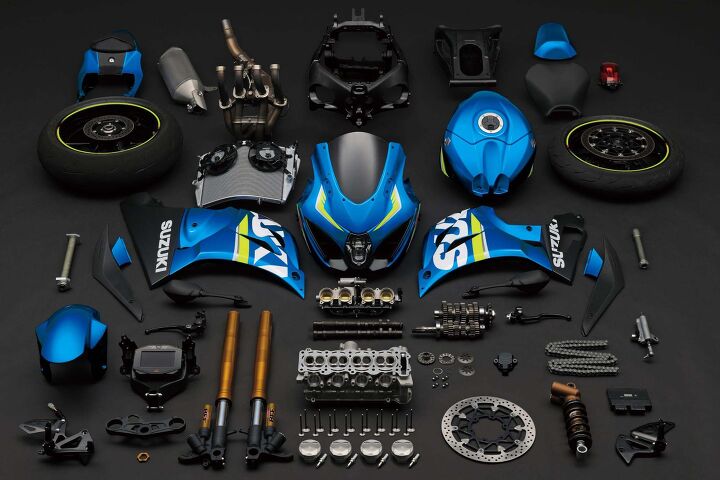






































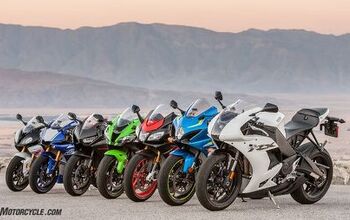

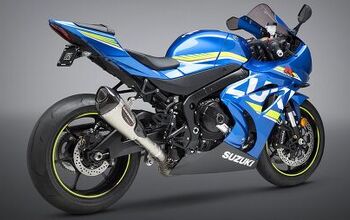

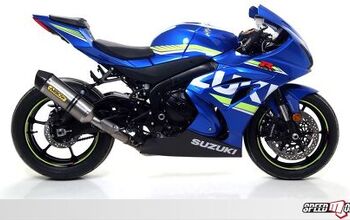











Comments
Join the conversation
'Bout time it made me a sandwich.
There better be a stripper and a case beer in that muffler!